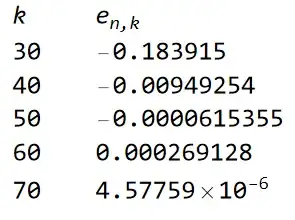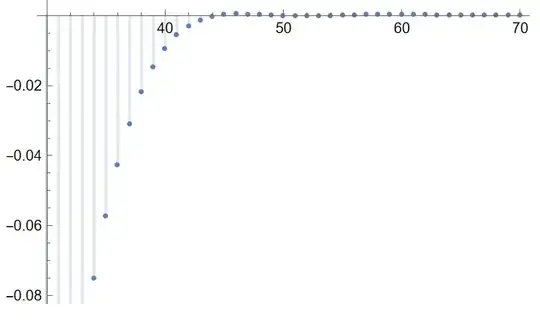I follow a subject almost like this link: Sum of 'the first k' binomial coefficients for fixed $N$ $$ f(N,k) = \sum^{k}_{i=0} \binom{N}{i} . $$ Michael Lugo suggest a way with geometric series : $$\sum^{k}_{i=0} \binom{N}{i} \leqslant \binom{N}{i} \cdot \frac{ n-k+1 }{(n-2\cdot k+1)}\label{1}\tag{ML} $$
Using Pascal's rule , $\binom{n}{k} + \binom{n}{k-1} = \binom{n+1}{k} $ , I compress the terms to obtain others series
$$
\begin{split}
\sum^{k}_{i=0} \binom{N}{i} & = \binom{n}{k} + \binom{n}{k-1} + \binom{n}{k-2} + \binom{n}{k-3} + \ldots \\
&= \binom{n+1}{k} + \binom{n+1}{k-2}+\dots\;.
\end{split}$$
This implies
$$
\begin{split}
\dfrac{ \sum^{k}_{i=0} \binom{N}{i} }{ \binom{n+1}{k} } & = 1 + \frac{(k-1) \cdot k}{(n-k+2) \cdot (n-k+3)} \\
& \quad + \frac{(k-3) \cdot (k-2) \cdot (k-1) \cdot k}{(n-k+2) \cdot (n-k+3) \cdot (n-k+4) \cdot (n-k+5)}\\
& \quad + \frac{(k-5) \cdot (k-4) \cdot (k-3) \cdot (k-2) \cdot (k-1) \cdot k}{(n-k+2) \cdot (n-k+3) \cdot (n-k+4) \cdot (n-k+5) \cdot (n-k+6) \cdot (n-k+7)} + \ldots\\ &\approx \frac{ (n-k+2) \cdot (n-k+3)}{(n+2) \cdot (n-2\cdot k+3)}
\end{split}
$$
the term of the series is $((k-1)\cdot k)/((n-k+2)\cdot(n-k+3)))$ so:
$$ \sum^{k}_{i=0} \binom{N}{i} \approx \binom{n+1}{k} \cdot\frac{ (n-k+2) \cdot (n-k+3)}{(n+2) \cdot (n-2\cdot k+3)} \label{2}\tag{F1}
$$
If we start at the third terms we have:
$$
\begin{split}
\frac{ \sum^{k}_{i=0} \binom{N}{i} }{ \binom{n+1}{k} } & = 1+ \frac{(k-1) \cdot k}{(n-k+2) \cdot (n-k+3)} \cdot \Bigg( 1 + \frac{(k-3) \cdot (k-2)}{(n-k+4) \cdot (n-k+5)} \\
&\quad+ \frac{(k-5) \cdot (k-4) \cdot (k-3) \cdot (k-2)}{(n-k+4) \cdot (n-k+5) \cdot (n-k+6) \cdot (n-k+7)}
+ \ldots \Bigg )\\
& \approx 1 + \frac{(k-1) \cdot k}{(n-k+2) \cdot (n-k+3)} \cdot \frac{(n-k+4) \cdot (n-k+5)}{(n+2) \cdot (n-2 \cdot k+7)}
\end{split} \label{3}\tag{F2}
$$
We can separate the series into 2 series, by taking only one terms on two which give:
$$
\begin{split}
& \frac{1 }{\binom{n+1}{k}} \cdot\Bigg( \binom{n+1}{k} + \binom{n+1}{k-4} + \binom{n+1}{k-8} + \ldots \Bigg) \\
& =
1+ \frac{(k-3)\cdot(k-2)\cdot(k-1)\cdot k}{(n-k+2)\cdot(n-k+3)\cdot(n-k+4)\cdot(n-k+5)} \\
&\quad + \frac{(k-7)\cdot(k-6)\cdot(k-5)\cdot(k-4)\cdot(k-3)\cdot(k-2)\cdot(k-1)\cdot k}{[(n-k+2)\cdot(n-k+3)\cdot(n-k+4)\cdot(n-k+5)\cdot(n-k+6)\cdot(n-k+7)\cdot(n-k+8)\cdot(n-k+9)]} \\
&\approx \frac{(n-k+2)\cdot(n-k+3)\cdot(n-k+4)\cdot(n-k+5)}{(n+2)\cdot(n-2\cdot k+5)\cdot(n^2-2\cdot k\cdot n+7\cdot n+2\cdot k^2-10\cdot k+12)}
\end{split}$$
thus
$$
\begin{split}
& \frac{1 }{\binom{n+1}{k}} \cdot\Bigg( \binom{n+1}{k-2} + \binom{n+1}{k-6} + \binom{n+1}{k-10} + \ldots\bigg) \\
& =
\frac{(k-1)\cdot k}{(n-k+2)\cdot(n-k+3)} \\
& \quad \cdot \Bigg( 1 + \frac{(k-5)\cdot(k-4)\cdot (k-3)\cdot(k-2)}{(n-k+4)\cdot(n-k+5)\cdot(n-k+6)\cdot(n-k+7)} \\
& \quad +
\frac{(k-9)\cdot(k-8)\cdot(k-7)\cdot(k-6)}{(n-k+4)\cdot(n-k+5)\cdot(n-k+6)} \\
& \quad\cdot\frac{(k-5)\cdot(k-4)\cdot(k-3)\cdot(k-2)}{(n-k+7)\cdot(n-k+8)\cdot(n-k+9)\cdot(n-k+10)\cdot(n-k+11)} + \ldots \Bigg) \\
& \approx \frac{(k-1)\cdot k}{(n-k+2)\cdot(n-k+3)} \\
& \quad \cdot \frac{(n-k+4)\cdot(n-k+5)\cdot(n-k+6)\cdot(n-k+7)}{(n+2)\cdot(n-2\cdot k+9)\cdot(n^2-2\cdot k\cdot n+11\cdot n+2\cdot k^2-18\cdot k+40)}
\end{split}
$$
and this implies
$$
\begin{split}
f(N,k) & \approx \binom{n+1}{k} \\
& \quad \cdot \Bigg(
\frac{(n-k+2)\cdot (n-k+3)\cdot(n-k+4)\cdot(n-k+5)}{(n+2)\cdot(n-2\cdot k+5)\cdot (n^2-2\cdot k\cdot n+7\cdot n+2\cdot k^2-10\cdot k+12)}\\
& \quad + \frac{(k-1)\cdot k}{(n-k+2)\cdot (n-k+3)}\\
& \quad \cdot \frac{(n-k+4)\cdot (n-k+5)\cdot (n-k+6)\cdot(n-k+7)}{(n+2)\cdot(n-2\cdot k+9)\cdot(n^2-2\cdot k\cdot n+11\cdot n+2\cdot k^2-18\cdot k+40)} \Bigg)
\end{split}\label{4}\tag{F3}
$$
This series are sharper, using the calculator PARI/GP , i found the following relative errors:
| (N,k) | (100,20) | (100,40) | (100,50) | (1000,200) | (1000,400) | (1000,500) |
|---|---|---|---|---|---|---|
| \ref{1} | 0.00626 | 0.10740 | 6.51962 | 0.00069 | 0.01563 | 23.65358 |
| \ref{2} | 0.000784 | 0.05096 | 1.629873 | 0.000107 | 0.0096452 | 7.25888 |
| \ref{3} | 2.700 E-5 | 0.012036 | 0.371743 | 6.3169 E-6 | 0.0039623 | 2.623599 |
| \ref{4} | 3.810 E-6 | 0.0086979 | 0.41073 | 1.338 E-6 | 0.003315 | 2.913452 |
But my problem is that for any approximation when $k \to N/2$ the error is too large, as you can see, because the geometric term converge to one.
I am seeking for an approximate formulation of the sum of binomial coefficient for fixed $N$, with sharp bound, to be differentiable if needed. Can we transform the series to be valid when $k\to N/2 $?
Best regards

